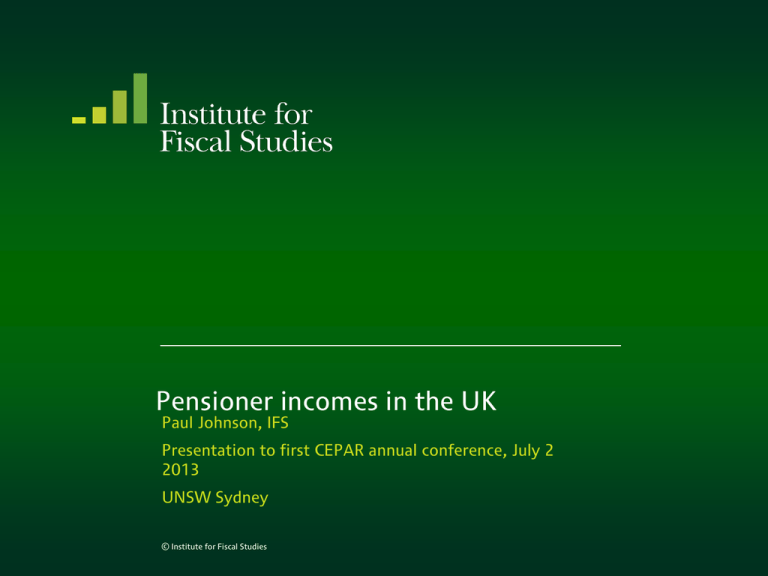Pensioner incomes in the UK Paul Johnson, IFS 2013
advertisement

Pensioner incomes in the UK Paul Johnson, IFS Presentation to first CEPAR annual conference, July 2 2013 UNSW Sydney © Institute for Fiscal Studies Pensioners and their incomes • The UK has traditionally had low state pension provision – And high levels of pensioner poverty • Much policy towards current pensioners seems to be predicated on this model of the world – Pensioners almost wholly protected from current austerity measures • But what has actually been happening to pensioner incomes over the last decades? – And why • And what about the future? © Institute for Fiscal Studies Background to the UK system (state) • We spend about 7% of GDP on state benefits for pensioners – Well below European average • Basic state pension at 15% of average earnings • Additional earnings related pension. – Average receipt about a third of basic pension • Significant means tested benefits – A fifth of pensioners receive “pension credit” – Also receipt of support for housing costs and local taxes • Additional universal add-ons – Winter fuel payment – Free bus travel – Free TV licences © Institute for Fiscal Studies Background to the UK system (private) • Historic high levels of occupational pension coverage – Average private pension receipt about £6,500 a year • Defined benefit schemes in private sector almost all closed to new members – Public sector still provides generous coverage • Around half of private workforce in some form of DC scheme – Should increase rapidly with auto enrolment – But contributions – and hence future benefits – much lower than DB © Institute for Fiscal Studies The world 30 years ago • Pensioner incomes were on average only about half those of the working age population • Note – throughout incomes are household incomes, net of taxes and receipt of benefits, and equivalised. Also generally net of housing costs – Using Family Resources Survey and Family Expenditure Survey data © Institute for Fiscal Studies Median income by age (GB) After housing costs, 1978-1980 Median income (£ per week) 500 450 400 350 300 250 200 150 100 Age Notes and source: see Figure 5.6 of Living Standards, Poverty and Inequality in the UK: 2013 The world 30 years ago • Pensioner incomes were on average only about half those of the working age population • Pensioners were concentrated in the bottom quintiles of the income distribution © Institute for Fiscal Studies Two thirds of pensioners in bottom two quintiles (AHC) 100% 1979 1979 1979 90% 80% 70% 60% 50% 40% 30% 20% 10% 0% Parents and children 1st quintile (lowest income) Pensioners 2nd 3rd Working-age without children 4th 5th quintile (highest income) Notes and source: see Figure E.1 of Living Standards, Poverty and Inequality in the UK: 2013 The world 30 years ago • Pensioner incomes were on average only about half those of the working age population • Pensioners were concentrated in the bottom quintiles of the income distribution • And pensioner poverty rates much higher than for rest of the population © Institute for Fiscal Studies Relative poverty rates by age group (AHC) 1978-80 40% 35% 30% 25% 20% 15% 10% 5% 0% Source: Figure 6.3a of Living Standards, Poverty and Inequality: 2013 © Institute for Fiscal Studies This state of affairs driven by: • Low flat rate basic pension at around 20% of average earnings – To which many, especially women, did not have full entitlement • Minimal earnings related top ups • Minimum means-tested benefits well below poverty line • Significant private incomes available only to a small minority – Related to rules of DB pension schemes more than coverage – Little or no protection against inflation, or for early leavers © Institute for Fiscal Studies Pensioner income sources (GB) State pensions and other benefits Private pensions Savings and investments Earnings and self-employment income Other Contribution to income (£ per week) 1,000 1978–1980 900 800 700 600 500 400 300 200 100 0 -100 1 2 3 4 5 All Pensioner income quintile Notes and source: see Figure 5.3 of Living Standards, Poverty and Inequality in the UK: 2013 Things have changed dramatically since then • Median pensioner incomes are now similar to those of the working age population © Institute for Fiscal Studies Median incomes vary little by age After housing costs, 2011-12 After housing costs, 1978-1980 Median income (£ per week) 500 450 400 350 300 250 200 150 100 Age Notes and source: see Figure 5.6 of Living Standards, Poverty and Inequality in the UK: 2013 A short digression • So far we have only been comparing current pensioners with current workers – What about actual replacement rates • We can look at those using ELSA • And we can define different measures of income – Taking account, or not, of the possibility that wealth might be annuitised • Replacement rates are high © Institute for Fiscal Studies Distribution of replacement rates 2008/09 100% Percentage of individuals 90% 80% 70% 60% 50% 40% Narrow 30% 20% Broad 10% 0% 0 © Institute for Fiscal Studies 25 50 75 100 125 150 175 Replacement of total net family income (%) Notes: One observation per individual, individuals aged 50 to SPA, assumes probabilistic selection into retirement 200 Proportion at risk of ‘inadequate’ resources Income coming from: Proportion falling below thresholds PCG (1) Pension wealth only (2) (1) plus non-housing wealth (3) (2) plus other wealth (4) (3) plus expected inheritances (5) (4) plus pension credit (6) (5) Replacing annuitised housing wealth with consumption flow © Institute for Fiscal Studies Notes: 2008/9, individuals aged 50 to SPA 67% 80% Proportion at risk of ‘inadequate’ resources Income coming from: (1) Pension wealth only (2) (1) plus non-housing wealth (3) (2) plus other wealth (4) (3) plus expected inheritances (5) (4) plus pension credit (6) (5) Replacing annuitised housing wealth with consumption flow © Institute for Fiscal Studies Notes: 2008/9, individuals aged 50 to SPA Proportion falling below thresholds PCG 67% 80% 12 41 53 Proportion at risk of ‘inadequate’ resources Income coming from: Proportion falling below thresholds PCG 67% 80% (1) Pension wealth only 12 41 53 (2) (1) plus non-housing wealth 10 30 42 (3) (2) plus other wealth (4) (3) plus expected inheritances (5) (4) plus pension credit (6) (5) Replacing annuitised housing wealth with consumption flow © Institute for Fiscal Studies Notes: 2008/9, individuals aged 50 to SPA Proportion at risk of ‘inadequate’ resources Income coming from: Proportion falling below thresholds PCG 67% 80% (1) Pension wealth only 12 41 53 (2) (1) plus non-housing wealth 10 30 42 (3) (2) plus other wealth 7 20 30 (4) (3) plus expected inheritances 7 18 28 (5) (4) plus pension credit - 12 22 (6) (5) Replacing annuitised housing wealth with consumption flow - 10 21 © Institute for Fiscal Studies Notes: 2008/9, individuals aged 50 to SPA Things have changed dramatically since then • Median pensioner incomes are now similar to those of the working age population • And pensioners are distributed across the income distribution © Institute for Fiscal Studies Pensioners now least likely to be in bottom quintile 100% 1979 1996 2011 1979 1996 2011 1979 1996 2011 Parents and children Pensioners Working-age without children 90% 80% 70% 60% 50% 40% 30% 20% 10% 0% 1st quintile (lowest income) 2nd 3rd 4th 5th quintile (highest income) Notes and source: see Figure E.1 of Living Standards, Poverty and Inequality in the UK: 2013 And less likely to be poor than the working age 1978-80 2011-12 40% 35% 30% 25% 20% 15% 10% 5% 0% Source: Figure 6.3a of Living Standards, Poverty and Inequality: 2013 © Institute for Fiscal Studies Things have changed dramatically since then • Median pensioner incomes are now similar to those of the working age population • And pensioners are distributed across the income distribution • Driven by increases in income across the pensioner distribution © Institute for Fiscal Studies With annual growth greater and more even than for others (1978-1980 to 2011-12) Average annual real income change 4.0% Parents and children 3.5% Working-age without children 3.0% Pensioners 2.5% 2.0% 1.5% 1.0% 0.5% 0.0% -0.5% 10 20 30 40 50 Percentile point 60 -1.0% Notes and source: see Figure 5.2 of Living Standards, Poverty and Inequality in the UK: 2013 70 80 90 Inequality now lower among pensioners than any other age group 1978-1980 2011-12 6.0 5.5 90:10 ratio 5.0 4.5 4.0 3.5 3.0 2.5 2.0 0 5 10 15 20 25 30 35 40 45 Age (5-year bands) © Institute for Fiscal Studies 50 55 60 65 70 75 80 All income sources more important State pensions and other benefits Private pensions Savings and investments Earnings and self-employment income Other Contribution to income (£ per week) 1,000 2011–12 1978–1980 900 800 700 600 500 400 300 200 100 0 -100 1 2 3 4 5 All 1 2 Pensioner income quintile Notes and source: see Figure 5.3 of Living Standards, Poverty and Inequality in the UK: 2013 3 4 5 All Components of pensioner income £500 Average income £400 £300 £200 £100 £0 -£100 1961 1964 1967 1970 1973 1976 1979 1982 1985 1988 1991 1994 1997 2000 2003 2006 2009 Other income Earned income Investment income Deductions from income © Institute for Fiscal Studies State pension and benefit income Private pension income Self-employment income What has driven these changes – state incomes? • 75% increase in real benefit receipt – But NOT driven by increases in level of basic pension © Institute for Fiscal Studies 120 30 100 25 80 20 60 15 40 Real terms (LH axis) Relative to average earnings (RH axis) 10 © Institute for Fiscal Studies 2008 2003 1998 1993 0 1988 0 1983 5 1978 20 Value relative to average earnings (%) £ per week (April 2009 prices) Basic pension fell relative to average earnings What has driven these changes – state incomes? • 75% increase in real benefit receipt – But NOT driven by increases in level of basic pension • Bigger proportional increases at top than bottom • Increase in benefit incomes driven by – Increased entitlement to basic pension – Maturation of SERPS – Introduction of new universal benefits – Big increases in means-tested benefits © Institute for Fiscal Studies Tax benefit changes 1997-98 to 2010-11 Loss as a percentage of net income 30% 25% 20% 15% 10% 5% 0% -5% -10% Poorest 2 3 4 5 6 7 8 9 Richest Income decile group Pensioners © Institute for Fiscal Studies All All What has driven these changes – state incomes? • 75% increase in real benefit receipt – But NOT driven by increases in level of basic pension • Bigger proportional increases at top than bottom • Increase in benefit incomes driven by – Increased entitlement to basic pension – Maturation of SERPS – Introduction of new universal benefits – Big increases in means-tested benefits • Tax changes have also benefited pensioners © Institute for Fiscal Studies Average income tax and NI rates paid by workers and pensioners by income level Income tax and employee NICs as a % of earnings 40% 35% 30% 25% 20% 15% 10% 5% 0% £0 £10,000 £20,000 £30,000 £40,000 Annual gross income Age under 65, 1978-79 © Institute for Fiscal Studies Age under 65, 2011-12 £50,000 Average income tax and NI rates paid by workers and pensioners by income level Income tax and employee NICs as a % of earnings 40% 35% 30% 25% 20% 15% 10% 5% 0% £0 £10,000 £20,000 £30,000 £40,000 Annual gross income © Institute for Fiscal Studies Age 65-74, 1978-79 Age under 65, 1978-79 Age 65-74, 2011-12 Age under 65, 2011-12 £50,000 What has driven these changes – private incomes? • Driven largely by a four-fold increase in incomes from private pensions – Increases right across the distribution – Account for 10% of income even for poorest quintile – Most important income source for top quintile • This resulted in large part from a range of new protections against inflation and for job changers – Accommodated by strong stock markets • But for the future private DB schemes are dead or dying – And DC schemes will offer much less © Institute for Fiscal Studies Pensioners have done especially well recently • Their incomes have continued to grow since 2008 – In sharp contrast to those of other age groups © Institute for Fiscal Studies Growth in median income by age (BHC, GB) 2001–02 to 2007–08 2007–08 to 2011–12 4% Average annual growth 3% 2% 1% 0% -1% -2% -3% -4% 0s 10s 20s 30s 40s 50s Age Notes and source: see Figure 5.7 of Living Standards, Poverty and Inequality in the UK: 2013 60s 70s Pensioners have done especially well recently • Their incomes have continued to grow since 2008 – In sharp contrast to those of other age groups • Tax and benefit changes have largely protected pensioners – “Triple lock” on state pensions – No cuts to means-tested benefits – in contrast to those of working age – As yet no reduction in additional universal benefits © Institute for Fiscal Studies Changes January 2011 to April 2014 Loss as a percentage of net income 0.0% -0.5% -1.0% -1.5% -2.0% -2.5% -3.0% -3.5% -4.0% -4.5% -5.0% Poorest 2 3 4 5 6 7 8 9 Richest Income decile group Pensioners © Institute for Fiscal Studies All All But the future may not be so rosy • SERPS and S2P are disappearing and being replaced by much less generous single tier pension • Private sector DB schemes are disappearing – fewer than 10% of private sector employees are now active members of a DB occupational scheme – Down from a third in 1997 © Institute for Fiscal Studies 1978–79 1979–80 1980–81 1981–82 1982–83 1983–84 1984–85 1985–86 1986–87 1987–88 1988–89 1989–90 1990–91 1991–92 1992–93 1993–94 1994–95 1995–96 1996–97 1997–98 1998–99 1999–00 2000–01 2001–02 2002–03 2003–04 2004–05 2005–06 2006–07 2007–08 Number of members (000s) Recent trends in DB coverage 7,000 6,000 Public Private 5,000 4,000 3,000 2,000 1,000 0 Financial year © Institute for Fiscal Studies Notes & sources: see Figure 4.1 of Emmerson and Tetlow (2010). But the future may not be so rosy • SERPS and S2P are disappearing and being replaced by much less generous single tier pension • Private sector DB schemes are disappearing – fewer than 10% of private sector employees are now active members of a DB occupational scheme – Down from a third in 1997 • DC schemes are typically much less generous • Auto-enrolment will make only a modest difference © Institute for Fiscal Studies Conclusions • In many ways the last three decades have been a triumph. Pensioner poverty has fallen dramatically • Down to expansion in both occupational and state pensions • Current policy continues to protect current and soon to be pensioners • But the model is not being sustained – Generous occupational schemes in the private sector are gone – State pensions for the future will be lower • The present is no guide to the future © Institute for Fiscal Studies



